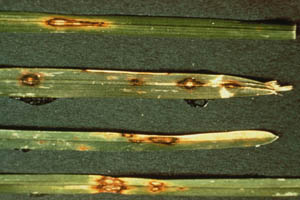Turfgrass Irrigation and Leaf Spot Irritation | |
|---|---|
| June 7, 2006 | |
|
Plant pathologists often talk about the Disease Triangle: the pathogen, host, and environment. However, I firmly believe that the word “me” should be added to this equation. Whether you maintain turfgrass for personal or professional purposes, your actions greatly influence turfgrass health. In particular, as we enter summer, it is important to consider the enormous impact of a seemingly simple act called irrigation. As you read this article, countless pathogenic fungi are hanging out in your lawn and hoping for just one thing this summer: That you will irrigate the lawn lightly, frequently, and late in the day! Though you may not notice it, the so-called “Helminthosporium” leaf-spotting fungi become active with warm (60? to 75?F) and moist conditions in the spring. However, as mentioned below, improper irrigation, coupled with various summertime stress factors, pushes the disease epidemic along, which may lead to a far more visible and serious symptoms called melting-out. Severe “Helminthosporium” melting-out symptoms may be confused with a very different disease called summer patch (discussed in issue no. 6 of this newsletter). Although the end-point symptoms for both diseases are the same (that is, dead patches that must be renovated), there are some differences in how you might go about preventing each disease. “Helminthosporium” leaf, crown, and root diseases are common on nearly all cool- and warm-season turfgrasses and are favored by prolonged leaf wetness and a variety of poor cultural practices and stress factors. Though there are many different fungi involved (now reclassified as species of Bipolaris, Drechslera, and Exserohilum) that are active over a wide temperature range, the control measures and fungal biology and symptoms are sufficiently similar, which makes it practical to discuss them together. Leaf spots appear on the leaves from early spring to autumn as small, dark brown, or purplish red spots. These enlarge and develop light-colored centers, with purplish black borders.  Infected leaf blades or entire plants may yellow, turn brown, wither, and die. Girdled leaf blades may drop prematurely. Crown and root rots usually appear in warm to hot weather as a reddish brown to black decay of the crown,  rhizome, and root tissues. Infected areas may have a brownish cast. The turf is thin and weak and may have a drought-injured appearance or be killed, resulting in round to irregular patches that enlarge during the summer.  This condition is called melting-out and is favored by wet weather. Stem, crown, and root rot occurs when feeder roots are shallow, few in number, or absent. Plants often wilt during midday, even with abundant soil moisture. Entire stands of turfgrass may be completely destroyed by severe crown and root rot. Resistance is a key component in controlling “Helminthosporium” diseases, and many resistant turfgrass varieties are available. The National Turfgrass Evaluation Program Web site (http://www.ntep.org) is an excellent resource to help turf managers determine the level of disease resistance for particular varieties at various locations. However, the resistance is diminished when turfgrass is subject to stress. The following cultural practices help to reduce stress and promote steady growth and thus are also very important in managing “Helminthosporium” diseases: (1) Irrigate deeply in the morning, but as infrequently as possible without causing stress. Water to the depth of the turf root system; that is, supply enough water in one irrigation to moisten the entire soil profile where roots are growing. Though you may find general irrigation guidelines, the best way to determine when to start and stop an irrigation cycle is to use a trowel or soil probe to check the soil moisture. (2) Increase the mowing height as high as the turf species and use allow. Turf that is cut too short usually lacks density, has a shallow root system, and is stressed. For cool-season species, the recommended mowing height is 2 to 3 inches. When healthy and actively growing, turf can be mowed at the lower end of this range. However, mow at the higher end during warm–hot periods or for turf stressed by drought, disease, shade, insects, or traffic. (3) Apply fertilizer only as needed to promote moderate growth, but do not overstimulate the turf in the spring and early summer. (4) Keep the thatch layer below 1/2-inch thick by core-aerifying, power raking, or vertical mowing. (5) Minimize the use of growth-regulator herbicides in disease-prone areas. If disease cannot be adequately controlled by cultural practices, a number of effective fungicides are available. However, control is impossible after late spring or summer when disease is already severe. The use of fungicides is most practical and effective when applied preventively in the spring to disease-prone areas. Fungicide recommendations are provided in the Illinois Commercial Landscape and Turfgrass Pest Management Handbook, as well as the Home, Yard, and Garden Pest Guide. For information about irrigation, mowing height, fertilization, and other aspects of turfgrass management, read the fact sheets provided by the U of I Extension Turfgrass Program at http://www.turf.uiuc.edu (click on the “Extension” link). |